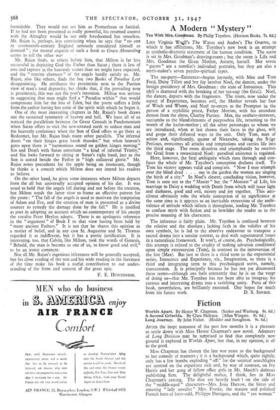A Modern " Mystery "
Tea With Mrs. Gooch:neat By Philip Toynbee. (Horizon Books. 75. 6d.)
LIKE Virginia Wo‘lf's The Waves and Auden's The Orators, to which it has affiliations, Mr. Toynbee's new book is an attempt at symbolic-dramatic statement of the human condition. The scene is set in Mrs. Goodman's drawing-room; but the room is Life and Mrs. Goodman the Great Mother, Astarte, herself. Her seven " guests " are a novelist's individual portraits, but they are also a myth-maker's seven psycho-spiritual types.
The tea-party—Existence—begins joyously, with Max and Tom Ford, Daisy Tillett and her fey brother Noel, the dancer, under the benign presidency of Mrs. Goodman: the state of Innocence. This idyll is shattered with the breaking of her tea-cup (the Grail). Noel, the dancer, departs with the fragments. The room, now under the aspect of Experience, becomes evil, the Mother reveals her face of Witch and Whore, and Noel re-enters as the Prompter in the person of a syphilitic priest, Father Morton, with his attendant demon from the abyss, Charley Parsley. Max, the aesthete-introvert, succumbs to the blandishments of purposeless life, returning to the womb of the harlot-mother ; all the other personages to whom we are introduced, when at last shown their faces in the glass, wilt and grope their defeated ways to the exit. Only Tom, man of action , and, significantly, quoter of Nietzsche, taking the Sqige Perilous, overcomes all attacks and temptations and carries life into the third stage. The room dissolves and triumphantly he receives the Grail from a resuscitated Noel: paradisal existence is regained.
Here, however, the fatal ambiguity which runs through and con- fuses the whole of Mr. Toynbee's conception declares itself. To Tom his victory appears valid and compete. "Now I may triumph over the blind dead . . . out in the garden the women are singing the birth of a city." In Noel's clearer, concluding vision, however, Tom is seen not as the "Master" but the " Monster " of Life, his marriage to Daisy a wedding with Death from which will issue light and darkness, good and evil, misery and joy together. This anti- climax obviously robs the whole conception of its significance at the same time as it appears as an inevitable expression of the ambi- valence of attitude which infects it throughout, leading Mr. Toynbee to confuse myth with fiction and to bewilder the reader as to the precise meaning of his characters.
The inference is fairly plain. Mr. Toynbee is confused between the relative and the absolute ; lacking faith in the validity of his own symbols, he is led to the abortive endeavour to transpose a sacred drama into a secular context, to deal with supernatural issues in a naturalistic framework. It won't, of course, do. Psychologically, this attempt is related to the crudity of making salvation conditional upon simple extroversion (Tom), in contrast to the introversion of the lost (Max). But just as there is a third term to the experiential series, Innocence and Experience, viz., Imagination, so there is a third and integrating term to this psychological series, namely, transcension. It is principally because he has not yet discovered these terms—although one feels constantly that he is on the verge of doing so—that Mr. Toynbee has not been able to integrate his curious and interesting drama into a satisfying unity. Parts of this book, nevertheless, are brilliantly executed. One hopes for much


































 Previous page
Previous page